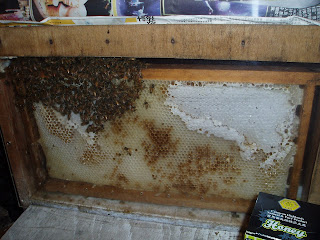I used to live in a kampong called Kang Kar, which is the present day Punggol Park, just opposite Serangoon Secondary School. The short bridge connecting Upper Serangoon Rd and Sengkang East Ave used to be the site of a famous fishing port where fishermen's catches were off-loaded in the wee hours of each morning.
Within the fencing where I lived, I remember there were 2 huge rambutan trees, a pulasan tree, custard apple trees, jambu trees, a durian tree, guavas and others. Around the kampong, I can remember coming across nutmegs, langsat and also, one big olive tree (which is around till today standing in the Nativity Church compound).
In the church compund also, there used to stand a huge fruit tree, which had to be cut down and in its place today stands a carpark. The tree used to be closed to the junction of the present Upper Serangoon Rd and Punggol Rd.
In the church compund also, there used to stand a huge fruit tree, which had to be cut down and in its place today stands a carpark. The tree used to be closed to the junction of the present Upper Serangoon Rd and Punggol Rd.
This is a native, but not well-known fruit tree that I want to enter into my blog today. Its called Buah Sentul(Malay), Buah Sng Too(Teochew & Hokkien) and Santol(English). I will not confound you - and myself - with its scientific name here though.


I used to miss the tree until quite recently, when I stumbled upon it and realised that this tree is now grown alongside many roads in Singapore. However, they are now much dwarfed in size. Some are low enough that their fruits can be picked by hands such as the one shown above. As far as I know, locally, the trees flower all year round, although they have a main season like most other fruits.


I used to miss the tree until quite recently, when I stumbled upon it and realised that this tree is now grown alongside many roads in Singapore. However, they are now much dwarfed in size. Some are low enough that their fruits can be picked by hands such as the one shown above. As far as I know, locally, the trees flower all year round, although they have a main season like most other fruits.
The AVA does really know their stuff and must be congratulated because, today the trees can be found along many expressways and estates all over Singapore. I understand that since the 80s, the AVA has started experimenting and growing fruit trees of many varieties, especially the native ones, all over Singapore to keep our heritage (trees being part of it).




It is not exactly the most popular fruit in this region, which explains why it is not commercialized here. On average the fruit is slightly bigger than a buah duku you see in the supermarket and slightly smaller than a tennis ball.
The rind (skin) is thick and very tough and needs a knife to open unlike the buah duku, which can be squeezed open if one has a pair of strong hands and fingers. The pulp of the buah sentul within, consisting of 4 or 5 segments, is eaten raw. It has a rather fluffy or buttery feel to it, while the taste borders between slightly acidic (sour) and sweet. It isn't very juicy either. This is based on my own taste and experience with the fruit.
The ripe fruit should be collected from the tree as fallen ones are usually already bad. Based on my own experience, the fruit is ripe when it is dark yellow, in comparison with others on the tree. You would also notice that it is relatively bigger in size. If it has a tinge of green or still a pale yellow, it should be left alone. The fruit at this stage will probably be too sour to eat.
But can one just take the fruits off any trees in Singapore? Well, it is officially an offence to pick fruits from any public trees in Singapore, notwithstanding some arguments that since we pay tax, by extension, we also own part of the tree. My own suspicion is, if you take a few for your own consumption, and do not injure or damage the trees, no one will bother you too much. However, this is only my own suspicion and one should also be aware that there are very "patriotic" people around nowadays who like to snoop on you and catch you red-handed with their camera phone. Having your face advertised in a place like Stomp and getting hit with darts is not to be taken lightly.
The ripe fruit should be collected from the tree as fallen ones are usually already bad. Based on my own experience, the fruit is ripe when it is dark yellow, in comparison with others on the tree. You would also notice that it is relatively bigger in size. If it has a tinge of green or still a pale yellow, it should be left alone. The fruit at this stage will probably be too sour to eat.
But can one just take the fruits off any trees in Singapore? Well, it is officially an offence to pick fruits from any public trees in Singapore, notwithstanding some arguments that since we pay tax, by extension, we also own part of the tree. My own suspicion is, if you take a few for your own consumption, and do not injure or damage the trees, no one will bother you too much. However, this is only my own suspicion and one should also be aware that there are very "patriotic" people around nowadays who like to snoop on you and catch you red-handed with their camera phone. Having your face advertised in a place like Stomp and getting hit with darts is not to be taken lightly.









































